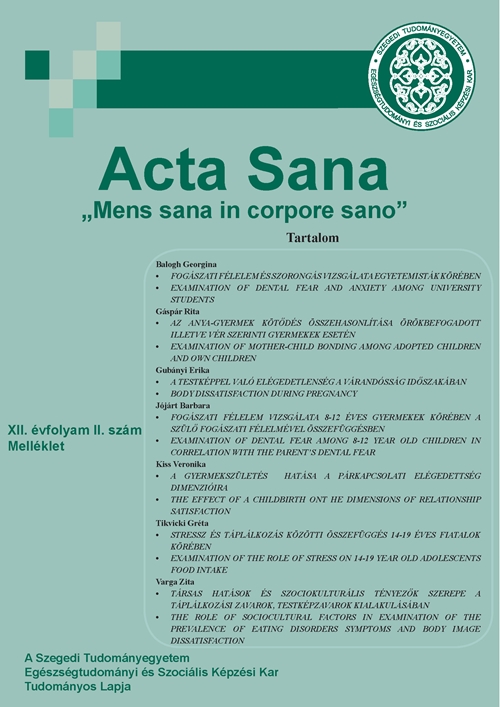Examination of dental fear and anxiety among university students
Main Article Content
Abstract
Introduction
Dental fear and anxiety has a high prevalence among young adults. According to the dental anxiety people do not take part on dental examination and treatments. Although dental anxiety is more common among women, it also affects men. University students on their first years are more anxious than students on their upper years in education. In addition, previous traumatic dental experiences are connected to participation on dental examinations.
Objective
The purpose of the study is to examine the dental anxiety and dental fear among 300 university students. We assume that among woman dental anxiety scores would be higher, than mans; we also assume that students at the beginning of their education has higher dental anxiety scores; we hypothesize that students who visit the dentist more regularly will be less anxious, however former traumatic event will be correlated to higher anxiety scores.
Method
Questionnaires will be used via internet to measure dental fear, dental anxiety and state and trait anxiety among university student.
Article Details
References
2. Corah, N. L. (1969). Development of a dental anxiety scale. Journal of dental research, 48(4), 596-596.
3. Corah, N. L., Gale, E. N., & Illig, S. J. (1978). Assessment of a dental anxiety scale. The Journal of the American Dental Association, 97(5), 816-819.
4. Nascimento, D. L. D., Araújo, A. C. D. S., Gusmão, E. S., & Cimões, R. (2011). Anxiety and fear of dental treatment among users of public health services. Oral health & preventive dentistry, 9(4): 329-337.
5. Galamb, D. és mtsai. (2010). A fogászati félelem mérésének lehetőségei. Orvostudományi Értesítő, 2010, 83 (4): 248-251
6. Saatchi, M., Abtahi, M., Mohammadi, G., Mirdamadi, M., & Binandeh, E. S. (2015). The prevalence of dental anxiety and fear in patients referred to Isfahan Dental School, Iran. Dental research journal, 12(3), 248.
7. Ali, S., Farooq, I., Khan, S. Q., Moheet, I. A., Al-Jandan, B. A., & Al-Khalifa, K. S. (2015). Self-reported anxiety of dental procedures among dental students and its relation to gender and level of education. Journal of Taibah University Medical Sciences, 10(4), 449-453.
8. Fábián T.K., Handa T., Szabó M., Kelemen P., Kaán B., Fábián G.: A dental Fear Survey (a “Fogászati félelem kérdőív”) magyar fordítása, hazai populáción végzett mérések eredményei. Fogorv Szle 1999; 92: 307-315.
9. Fábián T.K., Kelemen P., Fábián G.: A Dental Anxiety Scale (“Fogászati szorongás skála”) hazai bevezetése. Magyar populáción végzett szorongás-epidemiológiai vizsgálatok. Fogorv Szle 1998; 91: 43-52
10. Sipos K., Sipos M.: The development and validation of the Hungarian form of the STAI. In: Spielberger C.D., DiazGuerro R. (eds.): Cross-cultural Anxiety, 2. Washington-London, Hemisphere Publishing Corporation. 1978

